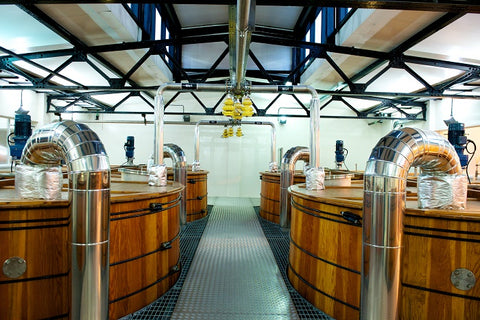“Moonshine” is distilled from the fermented sugar of a malt grains like oats, cornmeal, or wheat. A strong alcohol, the recipe for moonshine is very basic, which is why it has been popular throughout the years as something that can be made by amateur and professional distillers alike. While there are many successful (and delicious!) recipes for moonshine, here is a basic one that can be altered to fit the ingredients you have available or your taste preferences.
Making Moonshine Mash in 3 Steps
To make moonshine, you will combine your grains in an enclosed chamber with a fermenter, such as sugar or yeast. Add water, and you have a mixture that is called a “mash.” Mashes are used for other alcohols as well, such as whiskey. You’ll leave your mash in the chamber for a limited amount of time, to allow the sugars in the grains to turn into alcohol.
Before distilling, you can filter the solid husks and plant matter out of the mash. If you remove these solid materials, the liquid that is left is often called the moonshine or whiskey “wash.”
Either a mash or a wash can be distilled, so that the alcohol is separated from the water, and you can enjoy your own fine homemade whiskey.
Tips for Moonshine Mashes:
- Corn meal does not filter well out of a wash, and a cornmeal mash may burn the bottom of a copper still
- The first product in a distilling batch has the highest alcohol proof
- Measure your yeast fermentation and the mash’s alcohol content using a hydrometer
Step 1: Research and Purchase Ingredients
Basic Moonshine Mash Recipe
- 5 gallons of malt grains (rye, barley, or a combination of grains)
- 1 package of bread yeast
- 10 pounds sugar (any kind)
- 5 gallons warm water
Because moonshine has often been made in secret, there are no standardized measurements for the different ingredients in moonshine - it can be a process of trial and error to find a recipe that you like and that works well in your moonshine still.
Most people have used 5-gallon grain buckets to measure grains over the years, and that is often still a typical measurement given, because stills are also measured in gallons
Some recipes call for yeast, while others call for sugar. Ours, however, requires a bit of both. After a few runs, you may find that one type of fermenter over the other is right for you.
It’s best if you can use distilled water to make your moonshine mash, because you know that distilled water will not add any impurities that could throw off the fermentation process, or the flavor or alcohol content of your final product.
Step 2: Prepare Mash

In a fermentation chamber, combine approximately 5 pounds of sugar with 1-2 gallons of malt grain. Add warm water until the sugar dissolves - the water should be warm enough to dissolve the sugar but not hot enough that it kills the yeast.
Stir the mixture as the sugar dissolves. Continue stirring as you add the remaining grains, sugar, and water. Keep stirring until all sugar dissolves.
Step 3: Wait for Fermentation
Cover the fermentation container, while still allowing the mash to “breathe.” The mash can take 2 weeks or so for all the yeast to have turned as much sugar into alcohol as possible, if you let this process (called “clearing” the mash) happen naturally. However, you can use a product like Turbo Clear to shorten your fermentation time to as little as 4 days.
When the bubbles are large and slow to move to the top of the container, you might check to see if your mash is ready to distill. Distill the mash or wash in a clean, high-quality copper still, and your final moonshine should be between 90 and 140 proof, depending on the alcohol by volume of the mash.
Moonshines can be flavored during the mash, and there are hundreds of recipes that describe how to add varying ingredients to achieve different textures, flavors, and potencies of moonshine.
Moonshines can also be flavored after distillation, by having fruit soak in a container of moonshine for a number of days, then straining out the solid materials. Flavored moonshines can be combined into cocktails, and are even used in recipes for stews, desserts, dressings, and more.
There is no end to the uses for this versatile, easy-to-make, and strong-willed alcohol. Enjoy trying different moonshine recipes, and always enjoy your moonshine responsibly.
Article by: Jim Thomas
Photo credit: Logan Ingalls, Josh Rubin



